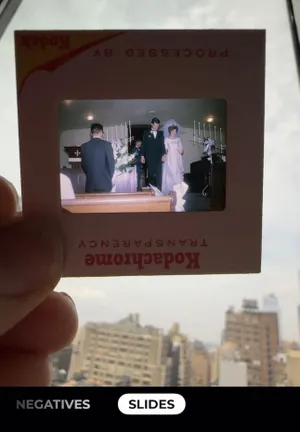Digital copies of old photos can keep your memories alive. Here’s how to scan them.
Long before we snapped an estimated 5.3 billion photos a day on our smartphones, people did their best to preserve lifetimes of images inside ancient albums, stuffed into shoeboxes, and crammed in closets.
Sadly, that’s where many of our most cherished moments remain – locked in dusty treasure chests just waiting to be rediscovered.
Finding them can be life-changing. But the real magic lies in restoring, digitizing, and displaying them again. I recently found that out myself.
Earlier this year, I shared a story about digitizing a lifetime of family photos in the wake of a family tragedy. It struck a nerve with so many readers that the "Today Show" just had me do a segment about it. Hundreds of you took the time to reach out and share your own stories and ask me some important follow-up questions, too.
Here are some additional answers to cracking the code on saving and sharing old photos and videos – for good.
How do I make digital versions of old photos?
Digitizing a lifetime of memories is a daunting task, and when those memories are spread across boxes of unorganized paper photos, VHS tapes, page-size prints, and sun-bleached photo albums, where do you start?
When I converted my massive photo and video collection into digital files, I went with ScanMyPhotos.com. I shipped off six cardboard boxes packed with nostalgia, and in less than 48 hours, I had over 6,000 digital photo and video files delivered to my door – along with all of my originals.
Prices vary depending on what you use but for an estimate:
- Photos: 13 cents per scan or $240 per box. (A box can hold about 1,800 pictures.)
- VHS: starts at $27 per tape.
We paid just $1,000 for six packed-to-the-gills boxes. Remember, this is an investment, too. Yes, it can be pricey, but you only have these physical copies, so if anything were to happen to them, they'd be lost permanently. It also takes a lot of time and energy to do on your own, so splurging could be worth it.
How to digitize old photos with your phone
If I could do it all over again, I’d do the exact same thing. But not everyone is in the same boat. Aside from the cost, you might not have nearly as many photos to digitize and some of your photos might be bent, bleached, or damaged beyond physical repair.
The good news is that there’s an app if you want to do it yourself. Actually, countless apps promise to help you digitize your photos and more – from one-click restorations to more involved DIY photo-fixing tools.
Photomyne

Photomyne caught my attention because it’s straightforward, fast, and free to try. Download the app to your iPhone or Android smartphone, snap a picture of your paper photo from within the app, and it’s saved forever.
The app also makes it easy to enhance the images. It can add color to faded photos, enhance faces to capture expression and crop the digital image so it’s framed just how you want it. There’s also the option to add color to black-and-white photos, though the results can be hit or miss.
It also does something that many photo digitization apps don’t even try to do: capture images from old slides and negatives. If you know anything about slide capture, you know that it usually must be done on a machine many times larger than your smartphone. Still, with an adequate backlight behind the slide – you can use a bright computer or tablet screen – and Photomyne’s backlight webpage grabs the images and turns them into digital photos.
Remember that this and every other photo-scanning app works best when scanning one photo at a time. You’ll get the highest level of detail and the best end-product. The downside is that if you have a thousand pictures to go through, you’ll need to call out sick from work for a month to get through them all. More serious photo scanning means choosing a more powerful tool.

D-I-Y Photo Scanning Station
Several options fit the bill, and the Memory Station by Vivid-Pix is a good pick. It combines a high-powered scanner and simple tools – like a thick piece of plexiglass to flatten photos perfectly – and then sends the images to the Vivid-Pix Restore software, which is free to try and costs $49.99 for the full version.
The software rewinds time on faded photos, brings the color and details out more, and enhances clarity to make them look better than ever.
The one drawback here is that there’s a learning curve for the software – which is available for both Windows and Mac computers. It’s not too bad, but plan at least 30 minutes to get the hang of it, with easy sliders and comparison tools to show you what changes you’re making and to preview the results. The Memory Station bundle, which includes the scanner and software, is another investment at $799.95.

How do I repair photos with an app?
For quick repairs without investing in a scanner, look to MyHeritage, which is better known for its genealogy services than its photo editing. But its app is surprisingly powerful for the latter. You can use the photo repair tool online or via the MyHeritage app, and you can also try it for free.
A simple upload of the photo lets you use a one-touch repair option that identifies scratches, tears, and other physical damage that made its way to your digital image. It removes these imperfections instantly, but it can be hit or miss if you have a severely damaged photo.
If you’re already a subscriber to MyHeritage’s complete plan for $299 per year, you can access full, unwatermarked photo repairs. If not, you can either subscribe, or pay $49 per year for the MyHeritage Reminage app, which includes just the photo editing features.
If you’re super dedicated to learning this photo restoration business, Adobe Photoshop gives you all the power you need and then some. You can make the usual tweaks to brightness, contrast, color, and so on, and you can also harness the power of AI. You’ll need to supply your own scanner for this or use one of the aforementioned smartphone apps. Still, once your photos are on your computer, the possibilities within Photoshop are endless.
With the Neural Filters feature built into Photoshop, you can utilize AI-powered photo restoration. Within this broader category are three specific tools that enhance faces, reduce noise, and repair physical damage like scratches that appear on photos you’ve scanned. These are handy tools, but learning to use them can take time, and Photoshop’s $22.99-per-month fee can be a turn-off.
Digitizing your memories:Memories tied up in boxes and boxes of pictures? Here's how to scan photos easily
Gifting, sharing, and displaying old photos
Your photos are all digitized, repaired, and ready to be enjoyed in all their glory – so now what?
My first move is always to dump my pics into Google Photos. With 15GB of free storage included with your regular old Google account, there’s lots of room. If you need more, say 100GB more, it’ll only set you back $2 per month, which is a small price to pay for precious photos that live forever.
Google Photos includes new AI tools to organize your images based on any number of things, including the content of the image itself. You can group similar photos and organize them into easy-to-find albums. It also uses AI to organize photos by categories, like people, places, trips, food, pets, so that you can more easily search and find what you’re looking for later. That's a must-have for extensive photo collections.
What’s the best way to print out photos?
If a physical photo is more your thing, FreePrints is one of the first places you should head. The app and the images you order from it are – you guessed it – free, but you pay shipping, which starts at around $2. Still, it gives you up to 85 free 4”x6” prints per month delivered as quickly as a couple of days. Once you run out of free prints, head to EasyPrints, MPix, or another high-quality, low-price option and fill those photo albums.
My go-to's for photo gifts
The Mixbook app is another excellent option for showcasing your photos. You can create incredible photo books from an app on your smartphone in about 10 minutes. Books start at $16 for soft cover or $20 for hard cover.
Mixbook's app incorporates a robust AI sorter that helps with photo selection and story curation. It helps identify your best photos – even ones buried in your camera roll – and then gives you layout recommendations and suggests photo captions. You can have total creative control or let automation do some of the heavy lifting for you.
Everyone has a handful of favorite photos on their devices, and Keepsake Frames is the easiest and most budget-friendly way to get those memories on the wall where they belong. (I have ordered at least a dozen frames from here, and I love every single one.) Just upload a photo from any device, pick out the exact frame color and look you want, and take care of everything in one easy go. You’ll get your photo – or, my new favorite, the collage frames with up to 200 photos – perfectly framed and headed to your door for as little as $29.
But Aura Frame is my No. 1 go-to gift for everyone – including myself: I have four of these in my own house. You can send photos from your phone to an Aura frame, and invite loved ones to contribute from anywhere they happen to be in the world through the app. It’s Wi-Fi-connected, comes with unlimited cloud storage, and plays videos (up to 30 seconds) and live photos. It can also use AI to find the best ones, and it includes a built-in quality filter so that only the best photos appear on the frame. You can use the Aura Frame app now to instantly scan and colorize old photos and add dates. You can also use it to display your kids’ artwork. These digital frames start at $149.
Jennifer Jolly is an Emmy Award-winning consumer tech columnist and on-air correspondent. The views and opinions expressed in this column are the author's and do not necessarily reflect those of USA TODAY. Contact her at JJ@Techish.com.
Disclaimer: The copyright of this article belongs to the original author. Reposting this article is solely for the purpose of information dissemination and does not constitute any investment advice. If there is any infringement, please contact us immediately. We will make corrections or deletions as necessary. Thank you.






